Angkor Wat
At some point during the four days I was in Seam Reap I emailed on of my friends the following, which she found utterly hilarious: “I can honestly say I have never been this hot or even close to this hot ever in my life. Right now it’s about 8 pm and I’m sitting with a fan blowing on me and that does nothing to stop the sweat pouring off of me. It’s hot. Hot hot hot. Fucking hot.” Which, aside from Angkor itself remains my overwhelming impression of the place.
I have since read in several places that mid March to mid April is the worst time to be in Seam Reap heat wise, but then again I never have been much for planning and that’s what you get when you don’t plan. So yes, it was hot. Really really hot. Think of Phoenix in the summer and then turn the humidity knob to the Spinal Tap favorite and you’ll be in the neighborhood.
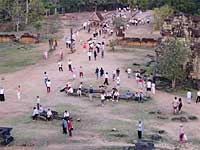 Three day passes to Angkor Wat can be purchased starting at 5pm in the evening and that evening does not count as one of the three days. I mentioned this to someone recently and they seemed a little surprised. “You spent three days at a temple?” Angkor Wat is, yes, a temple, but it’s not the only temple. Angkor, as the general area is known, contains more than 100 stone temples in all, and is all that remains of the grand religious, social and cultural seat of the Khmer Empire whose other buildings — palaces, public buildings, and houses — were built of bamboo and are long since decayed and gone. Angkor Wat itself is the largest religious structure in the world (Though I suppose if you wanted to get technical, Animists, Transcendentalists, Pagans and any of the Goddess/Nature religions have the worlds largest religious site, since the whole world is a religious site in those religions).
Three day passes to Angkor Wat can be purchased starting at 5pm in the evening and that evening does not count as one of the three days. I mentioned this to someone recently and they seemed a little surprised. “You spent three days at a temple?” Angkor Wat is, yes, a temple, but it’s not the only temple. Angkor, as the general area is known, contains more than 100 stone temples in all, and is all that remains of the grand religious, social and cultural seat of the Khmer Empire whose other buildings — palaces, public buildings, and houses — were built of bamboo and are long since decayed and gone. Angkor Wat itself is the largest religious structure in the world (Though I suppose if you wanted to get technical, Animists, Transcendentalists, Pagans and any of the Goddess/Nature religions have the worlds largest religious site, since the whole world is a religious site in those religions).
I have since read that roughly half a million people a year visit Angkor Wat. That first evening we decided to see just how tourist filled Angkor was by heading to the most popular sunset temple, Phnom Bakheng, to watch the sunset. There were a lot of tourists at Angkor Wat. Thousands of them. And that was just at one temple. Thus was hatched the plan. See Angkor in the heat of the day. Yes it will be hot. Hot hot hot. Fucking hot. But hopefully empty. What we were not counting on was the sudden appearance of Rob and Jules.
After splashing out of a lovely dinner at a posh hotel, the three of us were innocently walking around Seam Reap looking for a spot to have a drink when all the sudden I looked up to see a strange man shaking hands and hugging Matt. After traveling for a while the appearance of random people you know is not all that odd, and in fact we had even heard Matt mention that some of his friends were in the area. We had even heard a few stories, particularly about Rob. Debi and I briefly discussed whether or not we ought to fade away and let friends from home catch up. It’s one thing to run into people you have traveled with, that happens a good bit, but it’s rare to have visitors from home. After conferring once or twice we decided that what we had here was a beautiful opportunity to hear hilarious stories about Matt from two of the people that knew him best. And Rob did not disappoint, he is a master storyteller, particularly the embarrassing sort of stories that we wanted to hear. And while I decided I would not repeat any of them here, I do have a couple questions for you Matt… what were you planning to do with the toilet? How did you get a large tree into the room? And why of all things a ski jacket?
Anyway we stayed up far too late, drank far to many beer Lao and eventually decided that since sunrise was just around the corner anyway we might as well stay up all night and catch sunrise at Angkor Wat. 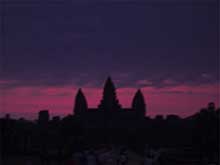 We started at Angkor Wat, which in spite of the row after row of coaches parked out front, didn’t feel as crowded as it was. I went in briefly, but did not spend too much time exploring. I went back outside and made a few quick photos and then lay down on a stone wall and watched the onslaught of temple goers heading inward.
We started at Angkor Wat, which in spite of the row after row of coaches parked out front, didn’t feel as crowded as it was. I went in briefly, but did not spend too much time exploring. I went back outside and made a few quick photos and then lay down on a stone wall and watched the onslaught of temple goers heading inward.
I was feeling a bit grumpy by the time we headed to Angkor Thom and Bayon. Our tuk-tuk driver had put me in a foul mood. Generally speaking the people of Southeast Asia are the nicest and warmest I’ve met; unless they happen to be tuk-tuk drivers, the majority of whom can choke on diesel fumes for all I care. Our tuk-tuk driver started out nice and friendly and then things went downhill when he found out we didn’t want to spend two hours inside Angkor Wat. Apparently he had agreed to another fare thinking that we would be in the temple for the standard amount of time. Unfortunately for him, this was not part of our plan. And this is the thing I hate about guides and drivers, you never get your experience, you get theirs. Eventually after arguing a bit, I simply walked away and let Matt use his diplomatic touch. I was all for the plan I used frequently in India—smile, jump out without paying and move on to the next tuk-tuk.
 I was going to skip Bayon and pass out in the tuk-tuk but since the driver was aggravating me, I decided to make a quick loop through the main courtyard. I did fall asleep in the tuk-tuk while Matt and Debi went to see a temple that didn’t look like anymore than a crumbled wall of stones to me.
I was going to skip Bayon and pass out in the tuk-tuk but since the driver was aggravating me, I decided to make a quick loop through the main courtyard. I did fall asleep in the tuk-tuk while Matt and Debi went to see a temple that didn’t look like anymore than a crumbled wall of stones to me.
I snapped to for Ta Prohm, which was the one temple I really wanted to see. Ta Prohm is the least restored, most overgrown of all the Angkor Temples and I was looking forward to seeing it. 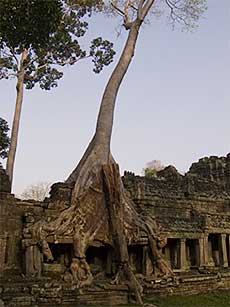 As I wandered about Ta Prohm I couldn’t shake the feeling that it all seemed somehow familiar to me. I started half thinking maybe I was getting in touch with a former life as a 700 AD Khmer priest when I overheard someone saying that Ta Prohm is where they filmed the first Tomb Raider movie. I’ve never seen the movie, but I did once for about a month get highly addicted to the game. I must confess to Shirley, that I really wanted to do some crazy kicking back flip combination move that would unlock all the cool weapons and find myself suddenly in possession of the grenade launcher, which was, in the context of the game, my favorite and highly overkill means of getting rid of the pesky bats that drain your energy bars.
As I wandered about Ta Prohm I couldn’t shake the feeling that it all seemed somehow familiar to me. I started half thinking maybe I was getting in touch with a former life as a 700 AD Khmer priest when I overheard someone saying that Ta Prohm is where they filmed the first Tomb Raider movie. I’ve never seen the movie, but I did once for about a month get highly addicted to the game. I must confess to Shirley, that I really wanted to do some crazy kicking back flip combination move that would unlock all the cool weapons and find myself suddenly in possession of the grenade launcher, which was, in the context of the game, my favorite and highly overkill means of getting rid of the pesky bats that drain your energy bars.
The real Ta Prohm has no bats, nor sadly, any sign of Angelina Jolie (though Cambodia is missing a small child; if anyone happens to run into her maybe mention it). It may not have been the religious experience it’s builders envisioned but I felt strangely connected to it nevertheless, if only through a video game.
The Angkor Temples are difficult to describe. For one thing all the temples are different and while they have common threads, such as sandstone blocks, they vary quite a bit in styles and even religion. The temples were built by various rulers of the Khmer Empire between 800-1400 CE during which time the principle religion was Hinduism. Thus the temples bear some resemblance to those I’ve seen in India, with bas-reliefs depicting Hindu mythology as well as the various exploits of kings and armies, but the architecture is unique and utilizes massive sandstone blocks. They are also all in varying conditions. 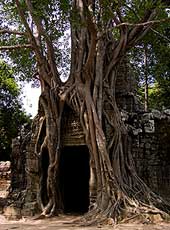 Many have been or are being restored. Others are still overgrown to the extent that it’s difficult to tell whether the creeper figs (remember creeper figs? They’re back) are holding up the walls or the walls are holding up the fig trees. I actually enjoyed the temples that were in various states of disrepair as they had more of a sense of history about them. After all one doesn’t really expect buildings over a thousand years old to be in that good of shape, especially in this climate.
Many have been or are being restored. Others are still overgrown to the extent that it’s difficult to tell whether the creeper figs (remember creeper figs? They’re back) are holding up the walls or the walls are holding up the fig trees. I actually enjoyed the temples that were in various states of disrepair as they had more of a sense of history about them. After all one doesn’t really expect buildings over a thousand years old to be in that good of shape, especially in this climate.
But restoration seems to be the wave of the future. I for one hope they don’t take it too far. However if they are going to take it too far, I have a suggestion. If they are going to restore the temples to “former grandeur” they may as well take the next step and improve upon them slightly. And what you may ask would I suggest as an improvement? Simple, the same thing I want every time I stand on top of something—zip lines. Think of it, you climb to the top of Angkor Thom or Angkor Wat, you don’t want to climb down, the reward is in the uphill; the downhill is just a necessity, or in the in case of Angkor Wat, vaguely dangerous. Zip lines are the way forward. Clip on and away you go. Angkor Wat is only ten years from being Disneyland anyway, might as well get started with the rides.
After falling asleep in the back of the tuk-tuk a second time we decided that perhaps skipping sleep, while adding a vaguely hallucinatory element to the temples, was maybe not the best way to see them. We went home and slept the remainder of the day. That evening over dinner we decided that tomorrow would be full on, none of this stopping at noon to get out of the heat crap. We set off just after dawn and did not return until after sunset. I climbed up and down so many temples I lost track of which were which, though truthfully I don’t think it ever mattered to me. I am not a historian nor am I a temple connoisseur. Angkor Wat is a grand experience, but describing it seems tedious. There are a whole lot of limestone blocks, vines, moss and carvings. 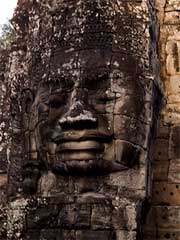 At its pinnacle it must have been quite a things to behold. But now it exists much like an echo, it gets inside you and bounces about in some way you can’t quite figure out. We spent the entire day dragging our grumpy and very reluctant tuk-tuk driver all over the place, not in the usual order, we just glance at the map and went here, then there, then back to here then… it was great, I’ve never enjoyed temples so much as when we sat in the shade of a pillar atop, well I could look up the name I suppose, but it really doesn’t matter. We sat in the shade of a pillar and looked down on the courtyard below and passed long periods of time in total silence praying for the occasional puff of wind the might make you temporarily feel like it was just hot, instead of hot hot hot.
At its pinnacle it must have been quite a things to behold. But now it exists much like an echo, it gets inside you and bounces about in some way you can’t quite figure out. We spent the entire day dragging our grumpy and very reluctant tuk-tuk driver all over the place, not in the usual order, we just glance at the map and went here, then there, then back to here then… it was great, I’ve never enjoyed temples so much as when we sat in the shade of a pillar atop, well I could look up the name I suppose, but it really doesn’t matter. We sat in the shade of a pillar and looked down on the courtyard below and passed long periods of time in total silence praying for the occasional puff of wind the might make you temporarily feel like it was just hot, instead of hot hot hot.
Later in the evening we went back to Angkor Wat proper to watch the sunset which was this time quite nice and not too many tourists about. I climbed up to the top and spent a good while dodging security guards who were trying to get everyone out before the sunset. I wanted to be up there to watch the sun actually set. Luckily the shadows deepen around then and with a bit of walking in carefully timed circles and sliding into darkened corners, I was able to pull it off. Eventually I wandered back out to the courtyard to find Matt and Debi passing a few surprised security guards on the way. If you planned ahead and brought a pillow you could probably spend the night up there. If you wanted to that is.
Like the Taj Mahal, Angkor Wat is, despite the hype, a pretty amazing monument. Its architecture is based around Hindu mythology with the five towers representing the peaks of Mount Meru the center of the universe (think of Meru as the Mt. Olympus of Hindu cosmology). The walls surrounding the temple are meant to represent the mountains at the edge of the world and the moat symbolizes the oceans beyond. Naturally this sort of embedded architectural meaning extends down to the smallest levels as well. The Entire wall of the inner temple is lined with various bas-reliefs that tell the story of Hinduism which one archeologist called the greatest linear stone carvings in the world. It’s no wonder that everywhere you go in Cambodia there’s a picture of Angkor Wat, from the flag to a can of beer.
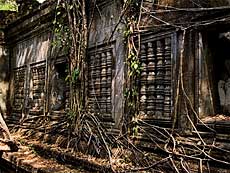 But that said, I think the best temple is actually outside the immediate area of Angkor. About sixty kilometers northeast of Angkor lies the temple of Beng Melea. Not only has it not been restored at all but the Khmer Rouge helped the forces of nature out a bit. What remains is a truly Indian Jones, buried in the jungle, sort of adventure that could awaken the amateur archeologist in even the most jaded of temple visitors. Beng Melea is also a sprawling large temple which covers over one square kilometer. As with Ta Prohm, Beng Melea is overrun by vegetation, giant piles of crumble stone are now buried beneath the descending roots of fig trees and the walls that still stand are spider webbed with roots and vines. There are very few carvings or bas-reliefs. Our guide claimed that when the temple was active it would have been covered in painted frescos and carvings, but the jungle and rain have claimed their own. Beng Melea was constructed before much of Angkor and may in fact have been a sort of prototype effort so it has a rough around the edges feel to it. At the time of its construction, Beng Melea sat on the crossroads of several major highways that ran to Angkor, Koh Ker, Preah Vihear (in northern Cambodia) and northern Vietnam. Now Beng Melea is quite removed from any crossroads and to get there required the longest tuk-tuk ride ever—something like two hours each way. I ended up thinking that perhaps a compromise is best, let Angkor Wat and Angkor Thom and the other temples be restored, but leave some, Ta Prohm and Beng Melea, the way they are, where they can continue to be slowly consumed by the jungle if only to remind us that while we made build epic monuments, the forces of decay always win in the end.
But that said, I think the best temple is actually outside the immediate area of Angkor. About sixty kilometers northeast of Angkor lies the temple of Beng Melea. Not only has it not been restored at all but the Khmer Rouge helped the forces of nature out a bit. What remains is a truly Indian Jones, buried in the jungle, sort of adventure that could awaken the amateur archeologist in even the most jaded of temple visitors. Beng Melea is also a sprawling large temple which covers over one square kilometer. As with Ta Prohm, Beng Melea is overrun by vegetation, giant piles of crumble stone are now buried beneath the descending roots of fig trees and the walls that still stand are spider webbed with roots and vines. There are very few carvings or bas-reliefs. Our guide claimed that when the temple was active it would have been covered in painted frescos and carvings, but the jungle and rain have claimed their own. Beng Melea was constructed before much of Angkor and may in fact have been a sort of prototype effort so it has a rough around the edges feel to it. At the time of its construction, Beng Melea sat on the crossroads of several major highways that ran to Angkor, Koh Ker, Preah Vihear (in northern Cambodia) and northern Vietnam. Now Beng Melea is quite removed from any crossroads and to get there required the longest tuk-tuk ride ever—something like two hours each way. I ended up thinking that perhaps a compromise is best, let Angkor Wat and Angkor Thom and the other temples be restored, but leave some, Ta Prohm and Beng Melea, the way they are, where they can continue to be slowly consumed by the jungle if only to remind us that while we made build epic monuments, the forces of decay always win in the end.
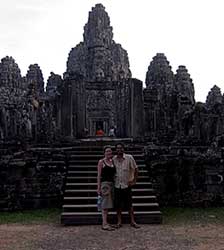 Beng Melea took the better part of the day. We arrived back in Seam Reap around three and ate a bit of lunch and lounged for a few hours. Then we decided to utilize our full three days and catch another sunset. Matt opted to take a nap but Debi and I dragged our perennially grumpy driver out to the park to have one last sunset. We went to Bayon since it isn’t a very good place to watch the sunset and there are few tourists there at that time of day. It was a nice quite way to end an experience that had begun rather full throttle, as if maybe Angkor still has a sort of hold over the world, can still make you slow down and be a bit humble in the face of it.
Beng Melea took the better part of the day. We arrived back in Seam Reap around three and ate a bit of lunch and lounged for a few hours. Then we decided to utilize our full three days and catch another sunset. Matt opted to take a nap but Debi and I dragged our perennially grumpy driver out to the park to have one last sunset. We went to Bayon since it isn’t a very good place to watch the sunset and there are few tourists there at that time of day. It was a nice quite way to end an experience that had begun rather full throttle, as if maybe Angkor still has a sort of hold over the world, can still make you slow down and be a bit humble in the face of it.
Thoughts?
Please leave a reply:
All comments are moderated, so you won’t see it right away. And please remember Kurt Vonnegut's rule: “god damn it, you’ve got to be kind.” You can use Markdown or HTML to format your comments. The allowed tags are
<b>, <i>, <em>, <strong>, <a>. To create a new paragraph hit return twice.